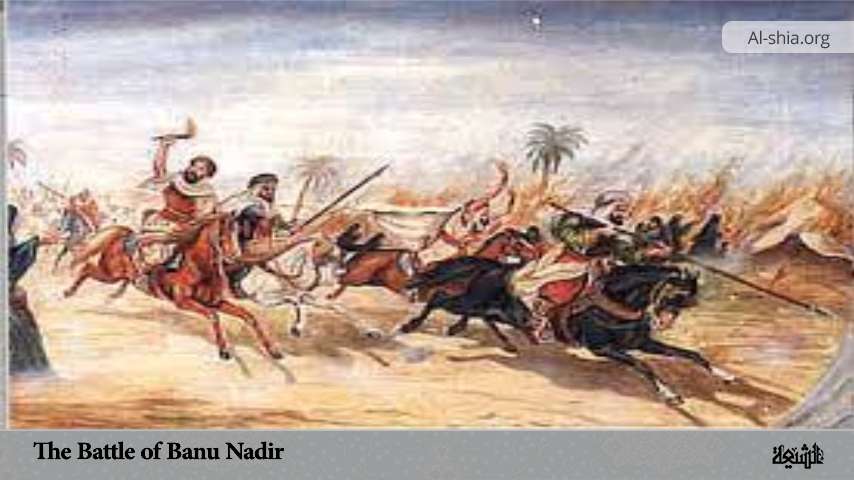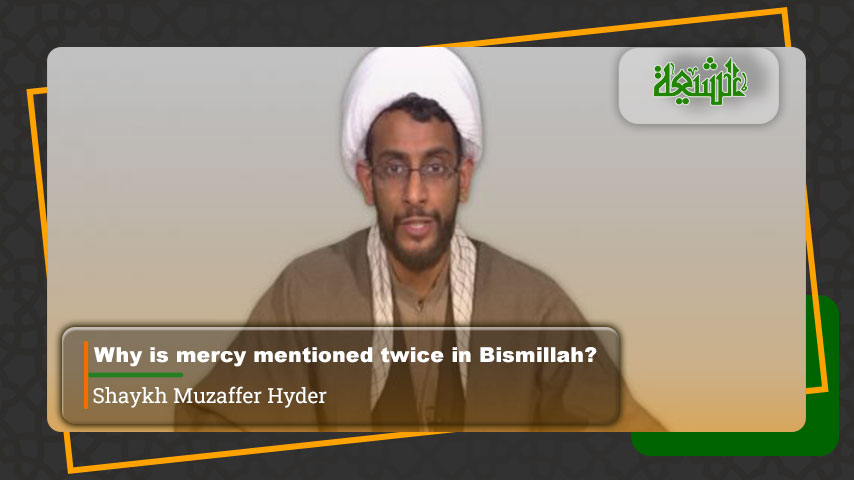The Banu Nadir tribe is one of the prominent Jewish tribes that resided in Yathrib before the emergence of Islam. The Battle of Banu Nadir is the second battle of the Prophet Muhammad (peace be upon him and his household) with the Jews of Medina This battle is a significant event within the narrative of early Islamic history, emphasizing its intricate intertwining of political, social, and religious factors prevalent in 7th-century Arabia. The comprehensive examination of the historical background provides invaluable insights into understanding the complexities of the Battle of Banu Nadir, marking it as not just a localized event but a critical moment encapsulating broader themes of loyalty, power, and intercultural relations in early Islamic society. The aim of the research paper therefore indicates a comprehensive approach toward understanding the lead-up to the battle, its immediate dynamics, and the subsequent ramifications. This indicates a methodological framework that will explore not just the tactical or military aspects but the broader socio-political consequences of the battle.
Historical Background
In early Medina, there were two major Arab tribes: the Banu Aws and the Banu Khazraj. In addition, there were three Jewish Arab tribes, the Banu Nadir, the Banu Qaynuqa, and the Banu Qurayza, who were also the Prophet’s allies[1]. In order to defeat or undermine the Jews, the Arabian tribes of Aws and Khazraj asked the Ghassanids for help. Ghassanids went to Hijaz with an army, killing many of the Jews. Since then, Aws and Khazraj have been dominant over the Jews[2]. In the quarrels between Aws and Khazraj, Banu Nadir took sides with Aws[3].
Meanwhile, there are different accounts about the origin of Banu Nadir. According to al-Ya’qubi in his Tarikh, their origin could be traced back to a clan of the Judham tribe who converted to Judaism and resided in the mountain of Nadir; and this is why they are called Banu Nadir[4]. On the contrary, Al-Sam’ani (an Arab historian) believes that the Banu Nadir tribe are the descendants of al-Nadir, a Jewish man who migrated from Judea to Arabia[5]. Thus, the name “al-Nadir” is probably derived from the Hebraic name “Ha-Nazir”. However, based on the account of another Arab historian, Ibn Hazm, he is of the opinion that the members of the Banu Nadir tribe are the direct patrilineal descendants of the Biblical Aaron[6].
Banu Nadir and other Medina-based Jews were very rich and lived in some of the best lands in Medina. The Banu Nadir along with Bani Qurayzah, and most of the Aws clans, situated in the Upper Section of Yathrib has a cooler climate and more fertile lands[7]. They earned their living through agriculture, usury, and trade in weapons and jewels, maintaining commercial relations with Arab merchants of Mecca[8]. Their fortresses were located half a day’s march to the south of Medina.
After the arrival of the Holy Prophet (peace be upon him and his household) to Medina, the establishment of the Constitution of Medina represents a foundational attempt to unify disparate tribes, promising cooperation between Muslims and Jewish clans[9]. The relationship between Muslims and the Jewish tribes, particularly Banu Nadir, is depicted as one initially marked by cooperation but increasingly marred by suspicion and hostility. The significance of the Battle of Badr marks a pivotal shift in this relationship, the Muslim victory challenged the status quo and generated anxiety among Jewish tribes, including Banu Nadir. The observations about Muslim perceptions of Banu Nadir’s betrayal speak to broader themes of security and survival in a society where trust was paramount for coalition-building.
Prelude to the Battle
The circumstances leading up to the Battle of Banu Nadir are crucial for understanding the motivations, tensions, and political manoeuvres that triggered this significant event in early Islamic history. This section will explore the diplomatic attempts between the Muslims and Banu Nadir, the key incidents that escalated tensions, and the implications of the broader geopolitical climate.
- Diplomatic Attempts and Treaties: As earlier stated, Banu Nadir prior to the conflict, was among the Jewish tribes that had entered into agreements with the Muslims, founded on mutual cooperation and respect for each other’s rights. The Constitution of Medina, established by Prophet Muhammad (peace be upon him and his household) after the Hijrah, outlined the obligations of both parties to protect each other and maintain peace within the city. Banu Nadir made a compromise treaty with Muslims, promising to help them defend Medina in the case of any attacks, refusing to provide financial and life support for the polytheists of Quraysh as well as commercial relations with them[10].
However, the deterioration of trust began following the Battle of Badr in 624 CE, when the Muslims emerged victorious against the Quraysh. This victory established Muhammad’s leadership and created apprehension among Banu Nadir, who viewed this burgeoning power with suspicion. The implications of Badr extended beyond a military victory; they altered the political landscape and increased the stakes for tribal alliances and enmities. Consequently, Banu Nadir breached the treaty[11].
- Allegations of Conspiracy: Following the Battle of Badr, suspicion grew towards Banu Nadir, particularly after credible accusations surfaced regarding their potential collusion with the Quraysh. A pivotal moment came when Banu Nadir was implicated in a conspiracy to assassinate Muhammad (peace be upon him and his household) as part of their perceived betrayal of the Muslim community[12]. This act was seen as a direct challenge to the authority of Prophet Muhammad and undercut the fundamental principles delineated in the Constitution of Medina[13]. The Prophet was informed by God about the conspiracy and gave them a deadline of ten days to leave Medina with all their movable property, except army equipment, and only come back annually to harvest their date groves.
- Tension over Treaties: Diplomatic attempts to calm tensions failed, as Banu Nadir reportedly violated the terms of their agreements with the Muslims. The violation of the treaties showcased a growing rift and bred distrust, marking a significant pivot from previously cooperative relations to hostile ones. The perception of betrayal left the Muslim community feeling vulnerable, leading to calls for action against the tribe.
Ultimately, the culmination of these tensions led to an ultimatum presented to Banu Nadir by Muhammad (peace be upon him and his household), demanding accountability for their alleged conspiratorial actions. When negotiations failed and the tribe refused to disavow their intentions, the environment became rife for military engagement. The impending sense of confrontation was inevitable given the collective feelings of insecurity in the Muslim community and the refusal of Banu Nadir to comply with the demands for peace while maintaining their alliances with the Quraysh[14]. (Esposito, 1998).
The Battle
The Battle of Banu Nadir, the second battle of the Prophet Muhammad (peace be upon him and his household) with Jews of Medina occurred in the month of Rabi’ al-Awwal of 4 AH (August, 625)[15].
According to reports, The Prophet before the battle appointed ‘Abd Allah b. Maktum as his successor in Medina and sieged Banu Nadir with an army under the commandership of ‘Ali ibn Abi Talib[16] for 15 days or 6 nights[17]. During the siege, a Jewish person called ‘Azwak attempted to kill the Prophet but he was killed by ‘Ali ibn Abi Talib[18].
The Jews later surrendered and agreed to leave Medina with only one load of a camel including their property, except army equipment, silvers, and gold[19]. Some of them, including Huyayy ibn Akhtab-whose daughter, Safiyya bint Huyayy, married the Prophet (peace be upon him and his household) after the Conquer of Khaybar in 7/628-9 and Abu al-Huqayq -Safiyya’s first husband- went to Khaybar, and others went to Syria[20].
Conclusion
The Battle of Banu Nadir, which occurred in the month of Rabi’ al-Awwal of 4 AH (August, 625) is the second battle of the Prophet Muhammad (peace be upon him and his household) with Jews of Medina. The lead-up to the Battle of Banu Nadir is marked by escalating tensions, broken treaties, and the fragility of alliances within a complex socio-political landscape. Factors such as the aftermath of the Battle of Badr, and allegations of conspiracy, combined to create a precarious environment that ultimately led to the confrontation. Understanding these elements is vital for comprehending the motivations behind the battle and the significant shifts in relationships that ensued within early Islamic society.
References
[1] . Rodinson (2002). Muhammad: Prophet of Islam, p. 213.
[2] . Abū l-Faraj Iṣfahānī, al-ʾAghānī, vol. 22, pp. 344-345.
[3] . Stillman, Norman (1979). The Jews of Arab Lands: A History and Source Book. pp. 13–14.
[4] . Yaʿqūbī, Aḥmad ibn Abī Yaʿqūb. Tārīkh al-yaʿqūbī, vol. 2, p. 43.
[5] . Abdulkarim al-Sam’ani (1988). Al-Ansab, vol. 4, p. 475.
[6] . Ibn Hazm (2009). Jawame Al-Syira Al-Nabawyia, p. 26.
[7] . Ismāilī, Mehrān (2021). Sākhtār-e Ijtemāʿī-ye Yathrīb dar Bonyān-e Madīnah al-Nabī, pp. 131-152.
[8] . Stillman, Norman (1979). The Jews of Arab Lands: A History and Source Book, p. 13–14.
[9] . Ibn Hisham, ʿAbd al-Malik (1936). Al-Sira al-Nabawiyya, Vol. I, p. 501.
[10] . Ibn Hishām, ʿAbd al-Malik (1936). al-Sīra al-nabawīyya, vol. 2, p. 148-150.
[11] . Ibn Saʿd, Muḥammad (1968). Al-Ṭabaqāt al-kubrā, vol. 2, p. 57.
[12] . Ibn Hishām, ʿAbd al-Malik (1936). al-Sīra al-nabawīyya, vol. 3, p. 199-200.
[13] . Wāqidī, Muḥammad b. ʿUmar (1996). Al-Maghāzī, vol. 1, p. 369.
[14] . Ṭabarī, Muḥammad ibn Jarīr (1387 AH). Tārīkh al-umam wa l-mulūk, vol. 2, p. 553.
[15] . Wāqidī, Muḥammad ibn ʿUmar (1996). Al-Maghāzī, vol. 1, p. 363.
[16] . Ibn Hishām, ʿAbd al-Malik (1936). al-Sīra al-nabawīyya, vol. 3, p. 200.
[17] . Ibn Hishām, ʿAbd al-Malik (1936). al-Sīra al-nabawīyya, vol. 3, p. 200.
[18] . Wāqidī, Muḥammad ibn ʿUmar (1996). Al-Maghāzī, vol. 1, p. 371.
[19] . Yaʿqūbī, Aḥmad ibn Abī Yaʿqūb. Tārīkh al-Yaʿqūbī, vol. 2, p. 49;
[20] . Ibn Kathīr al-Dimashqī (1415 AH). Al-Bidāya wa al-Nihāya, vol. 4, p. 75-76,

















